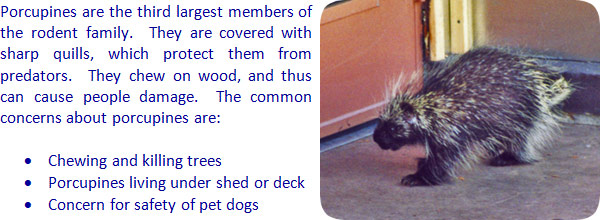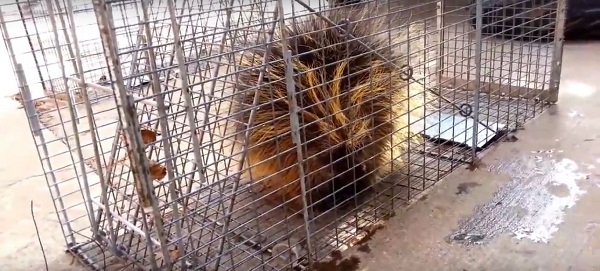 If you need help, click on my Nationwide List of Porcupine Removal Experts for a pro near you.
If you need help, click on my Nationwide List of Porcupine Removal Experts for a pro near you.
How to Kill a Porcupine -
Porcupines are capable of defending themselves at a distance like humans can with our firearms. It’s been recorded that porcupine quills can be launched up to distances of 18 feet. Of course, the closer the porcupine’s target is to the little fella, the more damage inflicted by the quill “spray” pattern. And the bigger the target, the more hits can be made. We heartily recommend avoiding contact with porcupines at all costs. Ha ha, just kidding, they can't shoot their quills. But they can destroy trees and landscaping.
Rural America is the preferred home of porcupines, especially where hemlock trees are in abundance. Remember though that porcupines will gnaw on any type of wood, factory processed or natural. Porcupines will destroy your yard furniture, your rooftop or siding. For homesteaders who have hemlock tree lots on their property, they should be concerned with porcupines nesting in their hemlocks.

Hemlock boughs have tips which are the preferred delicacy and food supply of the porcupine. A porcupine’s foraging habits can kill hemlock branches and, in extreme cases, the entire hemlock tree within a matter of months. Yet, environmental advocates are correct to wonder what hemlocks did before the onset of civilization and human hunters protecting tree stands.
Hemlock populations benefit from porcupine feeding habits. When porcupines kill hemlock branches by feeding on them they actually assist the hemlock population. The counterbalancing benefit to reduced shade cover from fewer branches is that more sunlight filters down onto the forest floor. In the process, more seeds can germinate with the emergent new trees renewing the wood lot. It is a relentless tug for survival in the lifecycle competition, and Nature has its own ways of keeping porcupines in check. The fisher is a bird that loves to dine on porcupine flesh. Some landowners are reintroducing fisher birds into their woodlots to hunt porcupines that are threatening to overrun hemlock tree lots.
Trapping porcupines is not recommended as an option for a beginniner. Use a professional service. The professionals will know how to remove the porcupines and how to deposit them far from your camp or homestead. Keep in mind, that the porcupines will find food if it is within 30 miles of their noses! Removing porcupines does not mean they won’t return. Trapping and removal consequently will make the porcupine someone else’s problem. However, the folks who insist on daring to try this method of population control themselves had better be tough or, at least, clothed accordingly.
Porcupine quills traveling under force of ejection can penetrate the toughest garb and gloves. If trapping, chunks of salt block make the best porcupine bait. Porkies love salt on everything. The only trouble with using salt as bait is that many other non-target animals could be lured into traps intended for porkies. A caged wire pen with a sensitive trip mechanism will work adequately to contain the porcupine. However, the cage should be made compact. Porcupines need very little elbow room to contort themselves and launch their quills. A caged porcupine is not a happy camper!
Trapping porkies is not for the novice. Porcupines are smart and can become bait shy. Becoming bait shy will cause the porcupine to avoid your traps next time. Perhaps the best approach to porcupine control is to make the foods they are attracted to (anything wood or salt coated, vegetables and shrubs) become unappealing by touch or taste. There are commercial products like “Ropel” that make wood taste bad to a porcupine. There are other products that can be used as coatings on tree trunks and wood shingle rooftops that make the wood feel sticky and unusual to the porcupine expecting to feed. Porcupines will move on after eating anything that they can. Remember, porcupines love salt and anything coated in it. So if you live in a rural area where roads are salted in winter, your tires will be fair game.
Shooting is probably the most humane approach to controlling porcupine populations. The stress of being trapped and penned for hours, sometimes for days, is not an easy experience for the porcupine that would remain vulnerable to threats from other animals while captive. Shotguns are effective lethal countermeasures. Small caliber rifles work well too. A double tap wound to the forehead using a .22 rifle will get the job done. Pistols are less safe due to their short-range requirements. Staying as far away from a surprised porcupine is a better idea than close quarter combat.